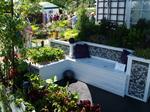Patios: Bringing The Garden Inside
Patios offer a wonderful opportunity to extend your living area into the garden. They are the perfect place for entertaining and enjoying the beauty of your garden from a sheltered spot.
What is a Patio?
A patio is defined in the dictionary as an "
inner court, of a Spanish house". Strictly speaking, a patio would be an enclosed garden area adjoining the house, most commonly bordered on 2 or 3 sides by walls of the house.
A patio would commonly be paved or covered with timber decking. It may or may not be bordered by garden bed. Any boundaries not bordered by the house would normally have a fence, hedge or wall which might be low or tall. There would probably be access into the rest of the garden from the patio.
Patios may be roofed. That is, they may have a pergola with climbers, shade cloth or solid roofing. If you have an area adjoining the house where it is difficult to grow a lawn or plants, either due to a large proportion of builders rubble in the soil or because of shade, a patio could be the perfect answer.
What to use a Patio For
- Protection from the weather. A covered patio will give shelter from rain showers and sudden gusts of wind. They can be designed to be cooler in summer and warmer in winter, making them useable for most parts of the year.
- Great for entertainment. Patios provide a solid surface to do your entertaining on. As such they offer an area to be used solely for a gathering or party, or as an overflow from indoors.
- Cooking on the patio will mean less fumes in the house. If you choose to invite guests around to eat, then you can prepare all the food outdoors.
- You can use your patio for sport and exercise. Weight training, aerobics and yoga are just some of the things that you can do on the patio in the fresh air. It also means that body odour doesn’t linger in the garage or house.
- Meetings: Business meetings or family get-togethers can be held outdoors on a well-equipped and protected patio.
- Relaxation: Why not take time out to read a book or contemplate life in the relaxing ambiance of the garden.

Designing a Patio for Winter Use
- Install a barbeque, fire pit, or build a pizza oven.
- Install a clear PVC roof
- Put on a North facing wall to catch sun
Designing a Patio for Summer Use
- Put on a south facing wall for summer sun protection
- Roof with climbers to provide shade, or opaque PVC
- Perhaps include a water feature for summer coolness and paddling feet
Designing a Patio for year-round Use
- Use a combination of clear and opaque PVC roofing
- Install deciduous climbers to let the sun in over winter but to protect from the sun in summer
- If you have limited space on your patio, then most things you are going to need come in a mobile form. Barbecues, furniture, parasols and log burners can be set-up and put away with the seasons allowing you to make the most of the available space.
Other Uses
- A patio can also serve as an area to put your indoor plants when they need rejuvenating.
- A patio can be an area to start a kitchen garden in pots allowing a ready supply of fresh herbs for cooking.
- A patio is a good place to grow plants from seed or small seedlings away from the ravages of the weather.
- It makes a great place for children to play and make mess which can be easily tidied up afterwards.
How big does a patio need to be?
- For a small dinner party or barbeque (4-6 adults) a patio of around 20 sq.m should suffice, bearing in mind that you need furniture, a barbeque, burner and so on depending upon the season.
- For a small party (up to 20 people) you will need around double this space. If a patio is only partly sheltered then you may be restricted to using it for parties only when the weather permits.
Want to Know More?
Consider doing a course or buying a reference book from our school.
If you would like to communicate with one of our professional tutors, consider using our free course counselling service. click for details
EBOOKS by our John Mason (Principal)
More from ACS
Ebook - Over 60,000 copies sold: a classic reference.
View eBook
Ebook - Shade types, creating shade, designs, shade plants, water, culture, propagation.
View eBook
Course - The opportunities for green walls and roofs will only increase as our cities continue to grow.
This is a solution to environmental and commercial problems on so many levels.
View Course
Course - Are you passionate about house plants or Interior Design? Start a career.
View Course
Course - improve your results and grow stunning flowers. Covers the major orchid genera e.g. Cymbidium, Dendrobium, Cattleya, Vanda and others.
View Course
Course - Great starter course for those with little knowledge but want to learn more.
View Course
Ebook - easy to read: home systems, commercial systems, media, fish species, fish care.
Planting guide and care; trouble shooting - fish and plants.
View eBook